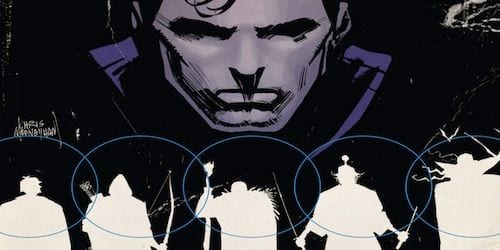
In comics storytelling, there’s a technique called the masking effect. It relies on the use of detail in the rendering of objects and characters. The masking effect equates less detail with the more iconic, more cartoony. Less detail, effectively means a greater participation by the reader; with more cartoony styles, less inking and linework, the reader animates the characters to a greater degree. More inking, more linework, greater degrees of photorealism means the opposite–increased emotional disassociation from the object or character in question.
To explain the masking effect, Scott McCloud (in his Understanding Comics), points to the robustness and flexibility of manga. Let’s say there’s a sword, McCloud posits. The sword’s cartoony and iconic while the hands of the character. But the moment the sword becomes a clue to a greater mystery, its representation becomes photorealistic, replete with ornate metalwork and gem-encrusting in the hilt. McCloud goes on to point to Herge’s classic Tintin series as an example of the masking effect. Look at Tintin or Captain Haddock or Thomson and Thompson, there’s so little linework it feels like they’re already parts of your own personality. Look at the world that Tintin inhabits on the other hand, and you’ll see something very different. Harsh lines and heavy inking make for profound reader disassociation. There’s so much detail here, in the bricks and the mortar and the tables and chairs, that it almost begins to feel like a real world. Almost like our real world.
Armed with nothing more than McCloud, Five Ghosts: the Haunting of Fabian Gray becomes a wonderland. Particularly the second-to-last page of the series’ most recent installment, issue #2, “Blood for the Spider-God!!” Artist Chris Mooneyham and colorists S.M. Vidaurri and Lauren Affe throw us into a sublime double-bind that seems to be uniquely the territory of pulp action stories. On this second to last page, Fabian and his stalwart companion Sebastian make their escape from the Temple of the Spider-God courtesy of tai chi master, Zhang Guo. (Even just writing that last line feels like a sublime liberation). Zhang Guo carries the passed-out Gray to a dirigible airship connected to the ground only by a precarious rope-ladder. Farther down the ladder, and swaying wildly and threatened by the spears of the Spider-tribe lobbed aloft, is Sebastian. But who do we associate more strongly with? The full-color, bright-as-the-light-of-day Sebastian that occupies the largest part of the page? Or Guo in less detail, purpled-out as he climbs towards the airship? Or the passed out Fabian himself, equally muted in a splash of purple?
This is just one of the sublime games that Five Ghosts is able to play with readers and fans alike. Almost every page contains a similar cache of puzzlemaking, a veritable cerebral adventure that harnesses the elements of the pulp tradition. All of which is down to the structure of the fictive world and its visualization that writer Frank Barbiere and artist Chris Mooneyham (working with colorists Vidaurri and Affe) have managed to build. The setup is simple enough. Gray is a treasure hunter with a skill set unlike any other — he is literally haunted by five ghosts; ultimate detective Sherlock Holmes, saint of the sword Miyamoto Musashi, wizard and architect of Camelot Merlin, brigand archer Robin Hood and immortal lovestruck vampire Dracula. It’s the 1930s, or maybe the ’40s, Nazis are everywhere and Fabian is seeking the means to free his twin sister from some manner of demonic enchantment that has left her comatose.
But the world-building doesn’t rely on Barbiere’s literary vision alone. To its credit, the world-building is a product of the strangest, most wondrous tango between writer and artist in recent memory. Artist Chris Mooneyham (together with colorists Vidaurri and Affe) openly embraces the pulp tradition. Reading Five Ghosts is exactly like reading pulp. It isn’t anything like reading the Shadow or the Spider or Operator #7 in this day and age. There’s no “resurrection” of the old pulp, no nostalgia for a bygone era. Reading Five Ghosts is reading pulp in the same way that pulp could be read when pulp reigned supreme in the ’30s and ’40s and earlier. There’s no postmodern quirkiness, no wink-of-the-eye, no tongue-in-cheek, this is just pure escapism and a thrill-ride of the finest order.
Five Ghosts: the Haunting of Fabian Gray is so novel, and so sincere in dealing with its own literary tradition, that it achieves that rare moment where it is able to elevate the genre itself. And in doing so it poses the question, what is the place for novelty, and perhaps in a deeper sense, what is the price of novelty, in a world where there’s nothing new under the sun?
